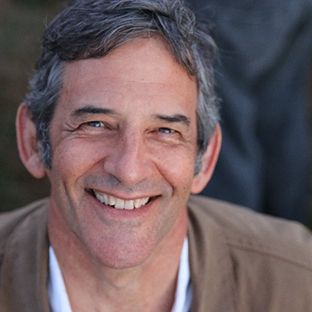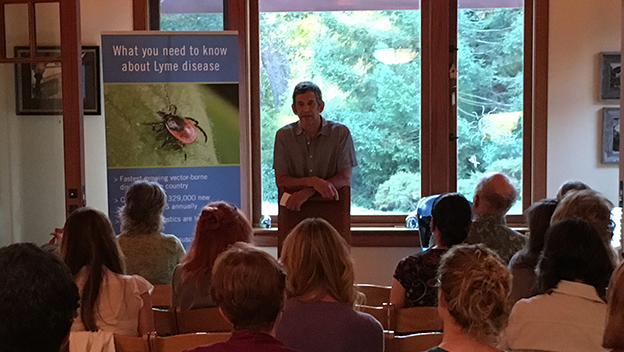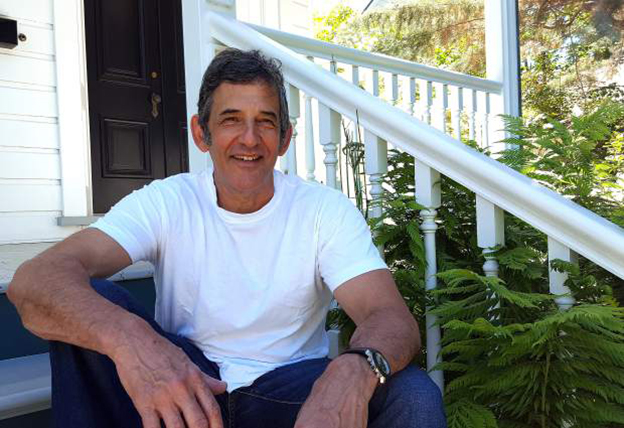 Wednesday evening September 14th, Jordan Fisher Smith, Lyme patient, former National Park Service (NPS) ranger and US Forest Service firefighter, narrator of the Lyme documentary Under Our Skin, freelance writer, and author of bestselling books, Nature Noir: A Park Ranger’s Patrol in the Sierra and Engineering Eden: The True Story of a Violent Death, a Trial, and the Fight Over Controlling Nature, was the latest to grace the Bay Area Lyme stage as part of the Distinguished Speaker Series. This free public series features noted scientists, health professionals, and Lyme advocates in intimate salon-style settings, where audience members can ask questions and get answers about the latest in Lyme disease research, treatments, and policy news. And sometimes, it’s just about sharing stories and insights.
Wednesday evening September 14th, Jordan Fisher Smith, Lyme patient, former National Park Service (NPS) ranger and US Forest Service firefighter, narrator of the Lyme documentary Under Our Skin, freelance writer, and author of bestselling books, Nature Noir: A Park Ranger’s Patrol in the Sierra and Engineering Eden: The True Story of a Violent Death, a Trial, and the Fight Over Controlling Nature, was the latest to grace the Bay Area Lyme stage as part of the Distinguished Speaker Series. This free public series features noted scientists, health professionals, and Lyme advocates in intimate salon-style settings, where audience members can ask questions and get answers about the latest in Lyme disease research, treatments, and policy news. And sometimes, it’s just about sharing stories and insights.
This week’s presentation was just that — a moving discussion of Jordan’s personal experience and reflections battling Lyme disease, what he describes as the toughest 9 1/2 years and biggest struggle of his life (and this from a man who nearly lost his life during blizzard conditions on the top of Mt. Shasta!).

It is the treacherous climb up Shasta as a young climber in his early 20s where Jordan’s story began last night — a wrenching cold winter escapade that went wrong when blizzard conditions suddenly moved in. Surviving an avalanche, extreme winds, collapsed snow caves, lost tents, frost bite, and hypothermia seems to have done little to dissuade Jordan from his love of the great parks and outdoor wilderness of the western US. He spent 21 years as a national park ranger and credits the “survival instinct” he learned along the way with later helping him battle his Lyme disease.
It was at least 20 years later when Jordan was infected with Lyme. He discovered a tick bite at his belt line that immediately developed into a bullseye skin rash. Remarkably, he knew enough to take the tick to show his doctor. Unfortunately, like many patients, Jordan encountered dismissive doctors — “there’s no Lyme disease in California,” they falsely asserted. One doctor even prescribed Prozac before sending him on his way.
It took five doctors and a year and half before he was finally diagnosed with both Lyme disease and Babesiosis, another tick-borne infection. It took several more years of treatment — “there is pretty much nothing I didn’t take or try” — before he began his climb back to health. In the interim, his symptoms became increasingly severe, ranging from pain and loss of feeling in his extremities, to blurred vision, ringing in his ears, periodic deafness, expansive skin rashes, extreme fatigue, disorientation, lack of spatial context, an inability to sleep or to do simple calculations, arthritis and joint problems, and sensory sensitivities. Eventually, he was forced to retire from the Park Service as he became unable to perform the everyday requirements of his job as a ranger — couldn’t hold a pistol, couldn’t navigate accurately, and was severely debilitated with pain.
So how did he get better? “I tried everything. There’s really nothing I did that is any different than anyone else.” What he did do was to relentlessly focus on four things — his self-architected protocol. As he described, it included: (1) managing the bacteria load (through antibiotics and probiotics), (2) doing everything in his power to restore what he describes as the “homeostasis of robust health” — through an active lifestyle, healthy eating, lots of sleep, etc.; (3) letting go of the anger so that he could focus on his health; and (4) being engaged and “not being a victim” (becoming active in political and public advocacy).
Now robust and healthy again, but having the scars of almost ten years of struggle, he reflected on his experience. What did he learn? He shared these final thoughts with the audience:
(1) Find your inner strength. Your pre-Lyme self has the natural abilities and power to be resilient. You need to tap into whatever that inner fire is and leverage it to get you through. For Jordan, it was a clear and raw survival instinct acquired from years of active outdoor wilderness training. For others, it might be the focus or centeredness that comes from practicing yoga or meditation.
(2) Be present. “There is light in the tunnel, not just at the end of the tunnel,” as one audience member interpreted. Focus on the positives today, do not be overwhelmed by the path ahead. And, “if you have a good day, celebrate it, enjoy it, call in sick!”
(3) Appreciate the caregivers. Lyme disease is hard and can be a long road. It will make you irritable. It will make you unhappy. It’s also invisible to most. You will need your closest companions. It’s difficult when the answer to how are you today is always “miserable.” Be sure to appreciate those who are closest to you.

Jordan Fisher Smith is currently on tour promoting his latest book, Engineering Eden. You can find information about Jordan’s upcoming speaking engagements on his website. His books are available for purchase on Amazon and at most local retailers.
For more information about the next Speaker Series event, click here.
I love the suggestion that today is the day to take time for yourself, have fun and celebrate because you are feeling good. I have had so many friends, family and clients who suffered endlessly with Lyme disease for years, some who found relief and some who sadly did not. The emotional well-being that can be found from taking the time to relax into the day cannot be overstated. Thank you for writing and posting such a thoughtful article on how to take better care of ourselves.
San Jose Counseling and Psychotherapy,
Dr. Randi Fredricks
http://drrandifredricks.com